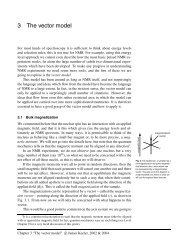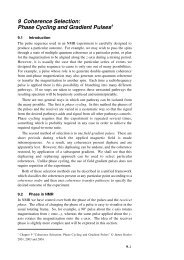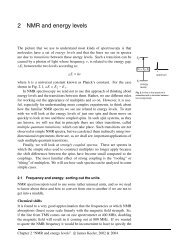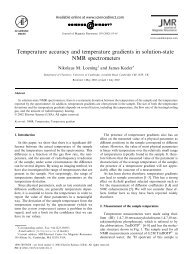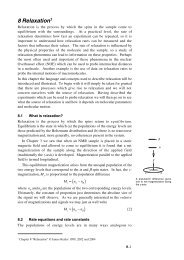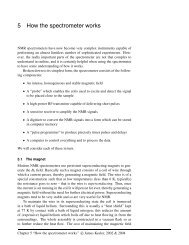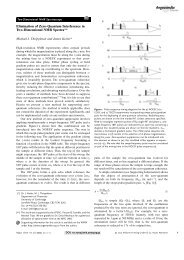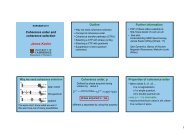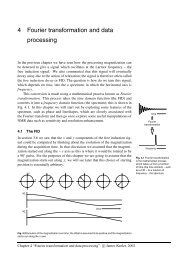Chapter 6: Product operators - The James Keeler Group
Chapter 6: Product operators - The James Keeler Group
Chapter 6: Product operators - The James Keeler Group
- No tags were found...
Create successful ePaper yourself
Turn your PDF publications into a flip-book with our unique Google optimized e-Paper software.
6 <strong>Product</strong> Operators †<strong>The</strong> vector model, introduced in <strong>Chapter</strong> 3, is very useful for describing basicNMR experiments but unfortunately is not applicable to coupled spin systems.When it comes to two-dimensional NMR many of the experiments are only ofinterest in coupled spin systems, so we really must have some way ofdescribing the behaviour of such systems under multiple-pulse experiments.<strong>The</strong> tools we need are provided by quantum mechanics, specifically in theform of density matrix theory which is the best way to formulate quantummechanics for NMR. However, we do not want to get involved in a great dealof complex quantum mechanics! Luckily, there is a way of proceeding whichwe can use without a deep knowledge of quantum mechanics: this is the productoperator formalism.<strong>The</strong> product operator formalism is a complete and rigorous quantummechanical description of NMR experiments and is well suited to calculating theoutcome of modern multiple-pulse experiments. One particularly appealingfeature is the fact that the <strong>operators</strong> have a clear physical meaning and that theeffects of pulses and delays can be thought of as geometrical rotations, much inthe same way as we did for the vector model in <strong>Chapter</strong> 3.6.1 A quick review of quantum mechanicsIn this section we will review a few key concepts before moving on to adescription of the product operator formalism.In quantum mechanics, two mathematical objects – wavefunctions and<strong>operators</strong> – are of central importance. <strong>The</strong> wavefunction describes the system ofinterest (such as a spin or an electron) completely; if the wavefunction is knownit is possible to calculate all the properties of the system. <strong>The</strong> simplest exampleof this that is frequently encountered is when considering the wavefunctionswhich describe electrons in atoms (atomic orbitals) or molecules (molecularorbitals). One often used interpretation of such electronic wavefunctions is tosay that the square of the wavefunction gives the probability of finding theelectron at that point.Wavefunctions are simply mathematical functions of position, time etc. Forexample, the 1s electron in a hydrogen atom is described by the functionexp(–ar), where r is the distance from the nucleus and a is a constant.In quantum mechanics, <strong>operators</strong> represent "observable quantities" such asposition, momentum and energy; each observable has an operator associatedwith it.Operators "operate on" functions to give new functions, hence their nameoperator × function = (new function)An example of an operator is ( ddx); in words this operator says "differentiate†<strong>Chapter</strong> 6 "<strong>Product</strong> Operators" © <strong>James</strong> <strong>Keeler</strong>, 1998 & 20026–1
with respect to x". Its effect on the function sin x isd( sin x)=cos xdxthe "new function" is cos x. Operators can also be simple functions, so forexample the operator x 2 just means "multiply by x 2 ".A mass going round a circularpath possesses angularmoment, represented by avector which pointsperpendicular to the plane ofrotation.p6.1.1 Spin <strong>operators</strong>A mass going round a circular path (an orbit) possesses angular momentum; itturns out that this is a vector quantity which points in a direction perpendicular tothe plane of the rotation. <strong>The</strong> x-, y- and z-components of this vector can bespecified, and these are the angular momenta in the x-, y- and z-directions. Inquantum mechanics, there are <strong>operators</strong> which represent these three componentsof the angular momentum.Nuclear spins also have angular momentum associated with them – calledspin angular momentum. <strong>The</strong> three components of this spin angularmomentum (along x, y and z) are represented by the <strong>operators</strong> Ix, Iy and Iz.6.1.2 Hamiltonians<strong>The</strong> Hamiltonian, H, is the special name given to the operator for the energy ofthe system. This operator is exceptionally important as its eigenvalues andeigenfunctions are the "energy levels" of the system, and it is transitions betweenthese energy levels which are detected in spectroscopy. To understand thespectrum, therefore, it is necessary to have a knowledge of the energy levels andthis in turn requires a knowledge of the Hamiltonian operator.In NMR, the Hamiltonian is seen as having a more subtle effect than simplydetermining the energy levels. This comes about because the Hamiltonian alsoaffects how the spin system evolves in time. By altering the Hamiltonian thetime evolution of the spins can be manipulated and it is precisely this that lies atthe heart of multiple-pulse NMR.<strong>The</strong> precise mathematical form of the Hamiltonian is found by first writingdown an expression for the energy of the system using classical mechanics andthen "translating" this into quantum mechanical form according to a set of rules.In this chapter the form of the relevant Hamiltonians will simply be stated ratherthan derived.In NMR the Hamiltonian changes depending on the experimental situation.<strong>The</strong>re is one Hamiltonian for the spin or spins in the presence of the appliedmagnetic field, but this Hamiltonian changes when a radio-frequency pulse isapplied.6.2 Operators for one spin6.2.1 OperatorsIn quantum mechanics <strong>operators</strong> represent observable quantities, such anenergy, angular momentum and magnetization. For a single spin-half, the x- y-6–2
and z-components of the magnetization are represented by the spin angularmomentum <strong>operators</strong> I x, I yand I zrespectively. Thus at any time the state of thespin system, in quantum mechanics the density operator, σ, can be representedas a sum of different amounts of these three <strong>operators</strong>σ()= t atI () x+ btI () y+ ctI () z<strong>The</strong> amounts of the three <strong>operators</strong> will vary with time during pulses and delays.This expression of the density operator as a combination of the spin angularmomentum <strong>operators</strong> is exactly analogous to specifying the three components ofa magnetization vector.At equilibrium the density operator is proportional to I z(there is only z-magnetization present). <strong>The</strong> constant of proportionality is usually unimportant,so it is usual to write σ eq= I z6.1.2 Hamiltonians for pulses and delaysIn order to work out how the density operator varies with time we need to knowthe Hamiltonian (which is also an operator) which is acting during that time.<strong>The</strong> free precession Hamiltonian (i.e. that for a delay), H free, isH free= ΩI zIn the vector model free precession involves a rotation at frequency Ω about thez-axis; in the quantum mechanical picture the Hamiltonian involves the z-angularmomentum operator, I z– there is a direct correspondence.<strong>The</strong> Hamiltonian for a pulse about the x-axis, H pulse, isHpulse, x= ω 1Ixand for a pulse about the y-axis it isHpulse, y= ω 1IAgain there is a clear connection to the vector model where pulses result inrotations about the x- or y-axes.6.1.3 Equation of motion<strong>The</strong> density operator at time t, σ(t), is computed from that at time 0, σ(0) , usingthe following relationshipσ()= t exp( −iHt) σ( 0) exp( iHt)where H is the relevant hamiltonian. If H and σ are expressed in terms of theangular momentum <strong>operators</strong> if turns out that this equation can be solved easilywith the aid of a few rules.Suppose that an x-pulse, of duration t p, is applied to equilibriummagnetization. In this situation H = ω 1I xand σ(0) = I z; the equation to be solvedisσ( tp)= exp( −iω1tpIx) Iz exp( iω1tpIx)Such equations involving angular momentum <strong>operators</strong> are common iny6–3
quantum mechanics and the solution to them are already all know. <strong>The</strong> identityrequired here to solve this equation is( ) ( )≡ −exp −iβI I exp iβI cosβ I sin β I[6.1]x z x z yThis is interpreted as a rotation of I zby an angle β about the x-axis. By puttingβ= ω 1t pthis identity can be used to solve Eqn. [6.1]σ( tp)= cosω1tp Iz−sinω1tpIy<strong>The</strong> result is exactly as expected from the vector model: a pulse about the x-axisrotates z-magnetization towards the –y-axis, with a sinusoidal dependence on theflip angle, β.6.1.4 Standard rotationsGiven that there are only three <strong>operators</strong>, there are a limited number of identitiesof the type of Eqn. [6.1]. <strong>The</strong>y all have the same form( ) ( )exp −iθIa{old operator} exp iθIa≡ cosθ{old operator} + sinθ{new operator}where {old operator}, {new operator} and I aare determined from the threepossible angular momentum <strong>operators</strong> according to the following diagrams; thelabel in the centre indicates which axis the rotation is aboutI II IIIxzz–y zyyx–y–x yx–x–z–zAngle of rotation = Ωt for offsets and ω 1 t p for pulsesFirst example: find the result of rotating the operator I yby θ about the x-axis,that is( ) ( )exp −iθI I exp iθIx y xFor rotations about x the middle diagram II is required. <strong>The</strong> diagram shows thatI y(the "old operator") is rotated to I z(the "new operator"). <strong>The</strong> required identityis therefore( ) ( )≡ +exp −iθI I exp iθI cosθ I sinθISecond example: find the result ofx y x y z( y){ z} ( y)exp −iθI – I exp iθIThis is a rotation about y, so diagram III is required. <strong>The</strong> diagram shows that –I z(the "old operator") is rotated to –I x(the "new operator"). <strong>The</strong> required identityis therefore6–4
( ) −{ } ( )≡ { − }+ { }exp −iθI I exp iθI cosθ I sin θ – Iy z y z x≡−cosθIz−sinθIxFinally, note that a rotation of an operator about its own axis has no effect e.g. arotation of I xabout x leaves I xunaltered.6.1.5 Shorthand notationTo save writing, the arrow notation is often used. In this, the term Ht is writtenover an arrow which connects the old and new density <strong>operators</strong>. So, forexample, the followingσ( tp)= exp( −iω1tpIx) σ( 0) exp( iω1tpIx)is writtenω1tI pσ( 0)⎯ x→σtFor the case where σ(0) = I z⎯⎯ ( p)1 p xI ⎯⎯⎯ →cos ω t I – sinωt Izω tI6.1.6 Example calculation: spin echo1 p z1 pa b e f90 x delayτ180 x delayτacquire°( ) °( )At a the density operator is –I y. <strong>The</strong> transformation from a to b is freeprecession, for which the Hamiltonian is ΩI z; the delay τ therefore correspondsto a rotation about the z-axis at frequency Ω. In the short-hand notation this isΩτI−I⎯z→σby⎯ ( )To solve this diagram I above is needed with the angle = Ωτ; the "new operator"yis I xΩτIz−I ⎯⎯→− cosΩτI + sin ΩτIyIn words this says that the magnetization precesses from –y towards +x.<strong>The</strong> pulse about x has the Hamiltonian ω 1I x; the pulse therefore correspondsto a rotation about x for a time t psuch that the angle, ω 1t p, is π radians. In theshorthand notationω− cosΩτ I + sin Ωτ I ⎯⎯⎯ 1p tI xyx→σ()e[6.2]Each term on the left is dealt with separately. <strong>The</strong> first term is a rotation of yabout x; the relevant diagram is thus IIω tI1 p x−cosΩτ I ⎯⎯⎯→−cosΩτcosω t I −cosΩτsinωt Iyyx1 p y1 pHowever, the flip angle of the pulse, ω 1t p, is π so the second term on the right iszero and the first term just changes sign (cos π = –1); overall the result isπIx−cosΩτI ⎯⎯→cosΩτIy<strong>The</strong> second term on the left of Eqn. [6.2] is easy to handle as it is unaffected byyz6–5
a rotation about x. Overall, the effect of the 180° pulse is thenπIx − cosΩτ I + sin Ωτ I ⎯⎯ →cosΩτ I + sin ΩτI [6.3]yxAs was shown using the vector model, the y-component just changes sign. <strong>The</strong>next stage is the evolution of the offset for time τ. Again, each term on the rightof Eqn. [6.3] is considered separatelyΩτIzcosΩτ I ⎯⎯→cosΩτcosΩτ I −sin ΩτcosΩτIyΩτIzsin Ωτ I ⎯⎯ →cosΩτsin Ωτ I + sin ΩτsinΩτIxCollecting together the terms in I xand I ythe final result iscosΩτcosΩτ + sin Ωτsin Ωτ I cosΩτsin Ωτ sin ΩτcosΩτI( ) + ( −)y<strong>The</strong> bracket multiplying I xis zero and the bracket multiplying I yis =1 because ofthe identity cos2 θ + sin2 θ = 1. Thus the overall result of the spin echo sequencecan be summarisedIz90° ( x)– − 180° x − −⎯⎯⎯⎯⎯ τ ( ) τ⎯→IIn words, the outcome is independent of the offset, Ω, and the delay τ, eventhough there is evolution during the delays. <strong>The</strong> offset is said to be refocused bythe spin echo. This is exactly the result we found in section 3.8.In general the sequence– τ – 180°(x) – τ – [6.4]refocuses any evolution due to offsets; this is a very useful feature which ismuch used in multiple-pulse NMR experiments.One further point is that as far as the offset is concerned the spin echosequence of Eqn. [6.4] is just equivalent to 180°(x).xyyyxyxxJ 12J 12Ω 1Ω 2<strong>The</strong> spectrum from two coupledspins, with offsets Ω 1 and Ω 2(rad s –1 ) and mutual couplingJ 12 (Hz).6.3 Operators for two spins<strong>The</strong> product operator approach comes into its own when coupled spin systemsare considered; such systems cannot be treated by the vector model. However,product <strong>operators</strong> provide a clean and simple description of the importantphenomena of coherence transfer and multiple quantum coherence.6.1.1 <strong>Product</strong> <strong>operators</strong> for two spinsFor a single spin the three <strong>operators</strong> needed for a complete description are I x, I yand I z. For two spins, three such <strong>operators</strong> are needed for each spin; anadditional subscript, 1 or 2, indicates which spin they refer to.spin 1: I I I spin 2 : I I I1x 1y 1z 2x 2y 2zI 1zrepresents z-magnetization of spin 1, and I 2zlikewise for spin 2. I 1xrepresents x-magnetization on spin 1. As spin 1 and 2 are coupled, thespectrum consists of two doublets and the operator I 1xcan be further identifiedwith the two lines of the spin-1 doublet. In the language of product <strong>operators</strong> I 1xis said to represent in-phase magnetization of spin 1; the description in-phase6–6
means that the two lines of the spin 1 doublet have the same sign and lineshape.Following on in the same way I 2xrepresents in-phase magnetization on spin2. I 1yand I 2yalso represent in-phase magnetization on spins 1 and 2,respectively, but this magnetization is aligned along y and so will give rise to adifferent lineshape. Arbitrarily, an absorption mode lineshape will be assignedto magnetization aligned along x and a dispersion mode lineshape tomagnetization along y.absorptiondispersionI 1xI 1yΩ 1Ω 2Ω 1Ω 2I 2xI 2y<strong>The</strong>re are four additional <strong>operators</strong> which represent anti-phase magnetization:2I 1xI 2z, 2I 1yI 2z, 2I 1zI 2 x, 2I 1zI 2 y(the factors of 2 are needed for normalizationpurposes). <strong>The</strong> operator 2I 1 xI 2zis described as magnetization on spin 1 which isanti-phase with respect to the coupling to spin 2.2I 1xI 2z2I 1yI 2z<strong>The</strong> absorption and dispersionlineshapes. <strong>The</strong> absorptionlineshape is a maximum onresonance, whereas thedispersion goes through zero atthis point. <strong>The</strong> "cartoon" formsof the lineshapes are shown inthe lower part of the diagram.Ω 1Ω 2Ω 1Ω 22I 1zI 2x2I 1zI 2yNote that the two lines of the spin-1 multiplet are associated with different spinstates of spin-2, and that in an anti-phase multiplet these two lines have differentsigns. Anti-phase terms are thus sensitive to the spin states of the coupled spins.<strong>The</strong>re are four remaining product <strong>operators</strong> which contain two transverse (i.e.x- or y-<strong>operators</strong>) terms and correspond to multiple-quantum coherences; theyare not observablemultiple quantum : 2I I 2I I 2I I 2I I1x 2y 1y 2x 1x 2x 1y 2yFinally there is the term 2I 1zI 2 zwhich is also not observable and corresponds to aparticular kind of non-equilibrium population distribution.αΩ 1βspin stateof spin 2<strong>The</strong> two lines of the spin-1doublet can be associated withdifferent spin states of spin 2.6.1.2 Evolution under offsets and pulses<strong>The</strong> <strong>operators</strong> for two spins evolve under offsets and pulses in the same way asdo those for a single spin. <strong>The</strong> rotations have to be applied separately to eachspin and it must be remembered that rotations of spin 1 do not affect spin 2, andvice versa.For example, consider I 1 xevolving under the offset of spin 1 and spin 2. <strong>The</strong>relevant Hamiltonian isH = Ω I + Ωfree 1 1z2I2z6–7
where Ω 1and Ω 2are the offsets of spin 1 and spin 2 respectively. Evolutionunder this Hamiltonian can be considered by applying the two terms sequentially(the order is immaterial)HfreetI1x⎯ ⎯→Ω1tI1z+Ω2tI2zI1x⎯⎯⎯ ⎯→Ω1tI1zΩ2tI2zI1x⎯⎯⎯→⎯⎯⎯→<strong>The</strong> first "arrow" is a rotation about zΩ1tI1zΩ2tI2zI ⎯⎯⎯ →cosΩtI + sin Ω tI ⎯⎯⎯→1x1 1x1 1y<strong>The</strong> second arrow leaves the intermediate state unaltered as spin-2 <strong>operators</strong>have not effect on spin-1 <strong>operators</strong>. Overall, thereforeΩ1tI1z+Ω2tI2zI ⎯⎯⎯ ⎯ →cosΩtI + sin Ω tI1x1 1x1 1yA second example is the term 2I 1xI 2zevolving under a 90° pulse about the y-axis applied to both spins. <strong>The</strong> relevant Hamiltonian isH = ω I + ω I1 1y1 2y<strong>The</strong> evolution can be separated into two successive rotationsω1tI1yω1tI2y2I 1 xI2 z⎯ →⎯⎯ ⎯⎯⎯→<strong>The</strong> first arrow affects only the spin-1 <strong>operators</strong>; a 90° rotation of I 1xabout ygives – I 1 z(remembering that ω 1t = π/2 for a 90° pulse)ω tI1x2z1 1x 2z 1 1z 2z1 1y1 2y2I I ⎯⎯⎯→cosωt2I I −sinωt2I I ⎯⎯⎯→1y2y2I I ⎯⎯⎯→−2I I ⎯⎯⎯→1x2zπ 2 I1z2z<strong>The</strong> second arrow only affects the spin 2 <strong>operators</strong>; a 90° rotation of z about ytakes it to xπ 2 I1y2y2I1xI2z⎯⎯⎯→−2I1zI2z⎯⎯⎯→−2I1zI2x<strong>The</strong> overall result is that anti-phase magnetization of spin 1 has been transferredinto anti-phase magnetization of spin 2. Such a process is called coherencetransfer and is exceptionally important in multiple-pulse NMR.6.1.3 Evolution under coupling<strong>The</strong> new feature which arises when considering two spins is the effect ofcoupling between them. <strong>The</strong> Hamiltonian representing this coupling is itself aproduct of two <strong>operators</strong>:H = 2 JπJ12 I1zI2zwhere J 12is the coupling in Hz.Evolution under coupling causes the interconversion of in-phase and antiphasemagnetization according to the following diagramsπ 2 Iπ 2Iω tI6–8
IVxVy–yzzzyzxzzz–xz–xangle = πJtFor example, in-phase magnetization along x becomes anti-phase along yaccording to the diagram d2πJ tI zIzI ⎯⎯⎯⎯ 12 1 2 →cosπJ tI + sinπJ t 2 I I1x–y12 1x 12 1y 2znote that the angle is πJ 12t i.e. half the angle for the other rotations, I–III.Anti-phase magnetization along x becomes in-phase magnetization along y;using diagram V:2πJ12tI1 zI2z2I I ⎯⎯⎯⎯ →cosπJ t2I I + sinπJ tI1x2z12 1x 2z 12 1y<strong>The</strong> diagrams apply equally well to spin-2; for example2πJ12tI1 zI2z−2I I ⎯⎯⎯⎯ →– cosπJ t2I I + sinπJ tI1z2y12 1z 2 y 12 2 xComplete interconversion of in-phase and anti-phase magnetization requires adelay such that πJ12t= π 2 i.e. a delay of 1/(2J 12). A delay of 1/J 12causes inphasemagnetization to change its sign:2πJ12tI1 zI2 z t= 1 2J12 2πJ12tI1 zI2 z t=1 J12I ⎯⎯⎯⎯⎯⎯→2I I I ⎯⎯⎯⎯⎯⎯→−I1x1y 2z 2y2 y6.4 Spin echoesIt was shown in section 6.2.6 that the offset is refocused in a spin echo. In thissection it will be shown that the evolution of the scalar coupling is notnecessarily refocused.6.4.1 Spin echoes in homonuclear spin systemIn this kind of spin echo the 180° pulse affects both spins i.e. it is a non-selectivepulse:– τ – 180°(x, to spin 1 and spin 2) – τ –At the start of the sequence it will be assumed that only in-phase x-magnetizationon spin 1 is present: I 1x. In fact the starting state is not important to the overalleffect of the spin echo, so this choice is arbitrary.It was shown in section 6.2.6 that the spin echo applied to one spin refocusesthe offset; this conclusion is not altered by the presence of a coupling so theoffset will be ignored in the present calculation. This greatly simplifies things.For the first delay τ only the effect of evolution under coupling need beconsidered therefore:2πJ12τI1 zI2 zI ⎯⎯⎯⎯ →cosπJ τ I + sinπJ τ 2I I1x12 1x 12 1y 2z<strong>The</strong> 180° pulse affects both spins, and this can be calculated by applying the6–9
180° rotation to each in successionπI1xπI2xcosπJ τ I + sinπJ τ 2I I ⎯⎯→⎯⎯→12 1x 12 1y 2zwhere it has already been written in that ω 1t p= π, for a 180° pulse. <strong>The</strong> 180°rotation about x for spin 1 has no effect on the operator I 1xand I 2z, and it simplyreverses the sign of the operator I 1yπI1 xπI2xcosπJ τI + sinπJ τ2I I ⎯⎯→cosπJ τI −sinπJ τ2I I ⎯⎯→12 1x 12 1y 2z12 1x 12 1y 2z<strong>The</strong> 180° rotation about x for spin 2 has no effect on the <strong>operators</strong> I 1xand I 1 y, butsimply reverses the sign of the operator I 2 z. <strong>The</strong> final result is thusπI1xcosπJ τI + sinπJ τ2I I ⎯⎯→cosπJ τI −sinπJ τ2I I12 1x 12 1y 2z12 1x 12 1y 2zπI2x⎯⎯ →cosπJ τI + sinπJ τ2I I12 1x 12 1y 2zNothing has happened; the 180° pulse has left the <strong>operators</strong> unaffected! So, forthe purposes of the calculation it is permissible to ignore the 180° pulse andsimply allow the coupling to evolve for 2τ. <strong>The</strong> final result can therefore just bewritten down:τ− 180° ( x)−τI ⎯⎯⎯⎯ →cos2πJ τ I + sin 2πJ τ 2I I1x12 1x 12 1y 2zFrom this it is easy to see that complete conversion to anti-phase magnetizationrequires 2πJ 12τ = π/2 i.e. τ = 1/(4 J 12).<strong>The</strong> calculation is not quite as simple if the initial state is chosen as I 1y, but thefinal result is just the same – the coupling evolves for 2τ:τ− 180° ( x)−τI ⎯⎯⎯⎯→− cos 2πJ τ I + sin 2πJ τ 2I I1yIn fact, the general result is that the sequence12 1y 12 1x 2z– τ – 180°(x, to spin 1 and spin 2) – τ –is equivalent to the sequence– 2τ – 180°(x, to spin 1 and spin 2)in which the offset is ignored and coupling is allowed to act for time 2τ.6.1.2 Interconverting in-phase and anti-phase statesSo far, spin echoes have been demonstrated as being useful for generating antiphaseterms, independent of offsets. For example, the sequence90°(x) – 1/(4J 12) – 180°(x) – 1/(4J 12) –generates pure anti-phase magnetization.Equally useful is the sequence– 1/(4J 12) – 180°(x) – 1/(4J 12) –which will convert pure anti-phase magnetization, such as 2I 1xI 2zinto in-phasemagnetization, I 1y.6–10
6.1.3 Spin echoes in heteronuclear spin systemsIf spin 1 and spin 2 are different nuclear species, such as 13 C and 1 H, it ispossible to choose to apply the 180° pulse to either or both spins; the outcome ofthe sequence depends on the pattern of 180° pulses.Sequence a has already been analysed: the result is that the offset is refocusedbut that the coupling evolves for time 2τ. Sequence b still refocuses the offset ofspin 1, but it turns out that the coupling is also refocused. Sequence c refocusesthe coupling but leaves the evolution of the offset unaffected.aspin 1spin 2bspin 1spin 2ττττSequence bIt will be assumed that the offset is refocused, and attention will therefore berestricted to the effect of the coupling2πJ12τI1 zI2 zI ⎯⎯⎯⎯ →cosπJ τ I + sinπJ τ 2I I1x<strong>The</strong> 180°(x) pulse is only applied to spin 112 1x 12 1y 2zπI1xcosπJ τ I + sinπJ τ 2I I ⎯⎯→cosπJ τ I − sinπJ τ 2I I [6.5]12 1x 12 1y 2z12 1x 12 1y 2z<strong>The</strong> two terms on the right each evolve under the coupling during the seconddelay:2πJ12τI1 zI2zcosπJ12τI1x⎯⎯⎯⎯→cosπJ τcosπJ τ I + sinπJ τcosπJ τ 2I I12 12 1x 12 12 1y 2z2πJ12τI1 zI2z−sinπJ12τ2I1yI2z⎯⎯⎯⎯→− cosπJ12τsinπJ12τ 2I1yI2 z+ sinπJ12τ sinπJ12τI1xCollecting the terms together and noting that cos2 θ + sin2 θ = 1 the final result isjust I 1 x. In words, the effect of the coupling has been refocused.cspin 1spin 2τThree different spin echosequences that can be appliedto heteronuclear spin systems.<strong>The</strong> open rectangles represent180° pulses.τSequence cAs there is no 180° pulse applied to spin 1, the offset of spin 1 is not refocused,but continues to evolve for time 2τ. <strong>The</strong> evolution of the coupling is easy tocalculate:2πJ12τI1 zI2 zI ⎯⎯⎯⎯ →cosπJ τ I + sinπJ τ 2I I1xThis time the 180°(x) pulse is applied to spin 212 1x 12 1y 2zπIxcosπJ τ I + sinπJ τ 2I I ⎯⎯2 →cosπJ τ I −sinπJ τ 2I I12 1x 12 1y 2z12 1x 12 1y 2z<strong>The</strong> results is exactly as for sequence b (Eqn. [6.5]), so the final result is thesame i.e. the coupling is refocused.SummaryIn heteronuclear systems it is possible to choose whether or not to allow theoffset and the coupling to evolve; this gives great freedom in generating andmanipulating anti-phase states which play a key role in multiple pulse NMRexperiments.6–11
6.5 Multiple quantum terms6.5.1 Coherence orderIn NMR the directly observable quantity is the transverse magnetization, whichin product <strong>operators</strong> is represented by terms such as I 1xand 2I 1zI 2 y. Such termsare examples of single quantum coherences, or more generally coherences withorder, p = ±1. Other product <strong>operators</strong> can also be classified according tocoherence order e.g. 2I 1zI 2 zhas p = 0 and 2I 1xI 2yhas both p = 0 (zero-quantumcoherence) and ±2 (double quantum coherence). Only single quantumcoherences are observable.In heteronuclear systems it is sometimes useful to classify <strong>operators</strong>according to their coherence orders with respect to each spin. So, for example,2I 1zI 2 yhas p = 0 for spin 1 and p = ±1 for spin 2.6.5.2 Raising and lowering <strong>operators</strong><strong>The</strong> classification of <strong>operators</strong> according to coherence order is best carried outbe re-expressing the Cartesian <strong>operators</strong> I xand I yin terms of the raising andlowering <strong>operators</strong>, I +and I –, respectively. <strong>The</strong>se are defined as followsI = I + iI I = I − iI[6.6]+ x y − x ywhere i is the square root of –1. I +has coherence order +1 and I –has coherenceorder –1; coherence order is a signed quantity.Using the definitions of Eqn. [6.6] I xand I ycan be expressed in terms of theraising and lowering <strong>operators</strong>( ) = ( )11Ix = 2 I+ + I− Iy 2 i I+ – I−[6.7]from which it is seen that I xand I yare both mixtures of coherences with p = +1and –1.<strong>The</strong> operator product 2I 1xI 2xcan be expressed in terms of the raising andlowering <strong>operators</strong> in the following way (note that separate <strong>operators</strong> are usedfor each spin: I 1±and I 2±)112I1 I = 22 × ( 2 I + 1I )× ( 1 2 I + 2I )x x + − + 2−[6.8]11= 2 ( I1 +I2+ + I1 −I2− )+ 2 ( I1 +I2− + I1 −I2+)<strong>The</strong> first term on the right of Eqn. [6.8] has p = (+1+1) = 2 and the second termhas p = (–1–1) = –2; both are double quantum coherences. <strong>The</strong> third and fourthterms both have p = (+1–1) = 0 and are zero quantum coherences. <strong>The</strong> value ofp can be found simply by noting the number of raising and lowering <strong>operators</strong>in the product.<strong>The</strong> pure double quantum part of 2I 1 xI 2xis, from Eqn. [6.8],1double quantum part[ 2I 1 xI 2 x]= 2 ( I 1 +I 2 ++ I 1 −I2 − ) [6.9]<strong>The</strong> raising and lowering <strong>operators</strong> on the right of Eqn. [6.9] can be reexpressedin terms of the Cartesian <strong>operators</strong>:6–12
( I I + I I )= ( I + iI )( I + iI )+( I −iI ) I − iI12 1+ 2+ 1− 2−[ ( )][ ]12 1x 1y 2x 2y 1x 1y 2x 2y1= 2 2I1xI2x + 2I1yI2ySo, the pure double quantum part of 2I 1xI 2xis 1 2 ( 2I1xI2x + 2I1yI2y); by a similarmethod the pure zero quantum part can be shown to be 1 2 ( 2I1xI2x − 2I1yI2y).Some further useful relationships are given in section 6.96.6 Three spins<strong>The</strong> product operator formalism can be extended to three or more spins. Noreally new features arise, but some of the key ideas will be highlighted in thissection. <strong>The</strong> description will assume that spin 1 is coupled to spins 2 and 3 withcoupling constants J 12and J 13; in the diagrams it will be assumed that J 12> J 13.6.6.1 Types of <strong>operators</strong>I 1xrepresents in-phase magnetization on spin 1; 2I 1xI 2zrepresents magnetizationanti-phase with respect to the coupling to spin 2 and 2I 1xI 3zrepresentsmagnetization anti-phase with respect to the coupling to spin 3. 4I 1xI 2zI 3 zrepresents magnetization which is doubly anti-phase with respect to thecouplings to both spins 2 and 3.As in the case of two spins, the presence of more than one transverseoperator in the product represents multiple quantum coherence. For example,2I 1xI 2xis a mixture of double- and zero-quantum coherence between spins 1 and2. <strong>The</strong> product 4I 1 xI 2xI 3zis the same mixture, but anti-phase with respect to thecoupling to spin 3. <strong>Product</strong>s such as 4I 1xI 2xI 3xcontain, amongst other things,triple-quantum coherences.6.6.2 EvolutionEvolution under offsets and pulses is simply a matter of applying sequentiallythe relevant rotations for each spin, remembering that rotations of spin 1 do notaffect <strong>operators</strong> of spins 2 and 3. For example, the term 2I 1xI 2zevolves underthe offset in the following way:Ω1tI1z Ω2tI2z Ω3tI3z2I I ⎯⎯⎯→⎯⎯⎯→⎯⎯⎯ →cosΩt 2I I + sin Ω t 2I I1x2z1 1x 2z 1 1y 2z<strong>The</strong> first arrow, representing evolution under the offset of spin 1, affects only thespin 1 operator I 1 x. <strong>The</strong> second arrow has no effect as the spin 2 operator I 2zandthis is unaffected by a z-rotation. <strong>The</strong> third arrow also has no effect as there areno spin 3 <strong>operators</strong> present.<strong>The</strong> evolution under coupling follows the same rules as for a two-spinsystem. For example, evolution of I 1 xunder the influence of the coupling to spin3 generates 2I 1 yI 3z2πJ tI zIzI ⎯⎯⎯⎯ 13 1 3 →cosπJ t I + sinπJ t 2 I I1x13 1x 13 1y 3zFurther evolution of the term 2I 1 yI 3zunder the influence of the coupling to spin 2generates a double anti-phase termJ 13J 12Ω 1α α β β spin 2α β α β spin 3<strong>The</strong> doublet of doublets fromspin 1 coupled to two otherspins. <strong>The</strong> spin states of thecoupled spins are alsoindicated.I 1x2I 1xI 2z2I 1xI 3z4I 1xI 2zI 3zRepresentations of differenttypes of <strong>operators</strong>.6–13
2πJ12tI1 zI2z2I I ⎯⎯⎯⎯→cosπJ t 2I I −sinπJ t 4I I I1y3z12 1y 3z 13 1x 2z 3zIn this evolution the spin 3 operator is unaffected as the coupling does notinvolve this spin. <strong>The</strong> connection with the evolution of I 1yunder a coupling canbe made more explicit by writing 2I 3zas a "constant" γ2πJ tI zIzγ I ⎯⎯⎯⎯12 1 2 →cosπJ t γ I −sinπJ t 2 γ I I1ywhich compares directly to12 1y 13 1x 2z2πJ tI zIzI ⎯⎯⎯⎯12 1 2 →cosπJ t I −sinπJ t 2 I I1y12 1y 13 1x 2z6.7 Alternative notationIn this chapter different spins have been designated with a subscript 1, 2, 3 ...Another common notation is to distinguish the spins by using a different letter torepresent their <strong>operators</strong>; commonly I and S are used for two of the symbols2I1xI2z ≡ 2IxSzNote that the order in which the <strong>operators</strong> are written is not important, althoughit is often convenient (and tidy) always to write them in the same sequence.In heteronuclear experiments a notation is sometimes used where the letterrepresents the nucleus. So, for example, <strong>operators</strong> referring to protons are giventhe letter H, carbon-13 atoms the letter C and nitrogen-15 atoms the letter N;carbonyl carbons are sometimes denoted C'. For example, 4C xH zN zdenotesmagnetization on carbon-13 which is anti-phase with respect to coupling to bothproton and nitrogen-15.6.8 Conclusion<strong>The</strong> product operator method as described here only applies to spin-half nuclei.It can be extended to higher spins, but significant extra complexity is introduced;details can be found in the article by Sørensen et al. (Prog. NMR Spectrosc. 16,163 (1983)).<strong>The</strong> main difficulty with the product operator method is that the more pulsesand delays that are introduced the greater becomes the number of <strong>operators</strong> andthe more complex the trigonometrical expressions multiplying them. If pulsesare either 90° or 180° then there is some simplification as such pulses do notincrease the number of terms. As will be seen in chapter 7, it is important to tryto simplify the calculation as much as possible, for example by recognizingwhen offsets or couplings are refocused by spin echoes.A number of computer programs are available for machine computationusing product <strong>operators</strong> within programs such as Mathematica or Maple. <strong>The</strong>secan be very labour saving.6–14
6.9 Multiple -quantum coherence6.9.1 Multiple-quantum termsIn the product operator representation of multiple quantum coherences it is usualto distinguish between active and passive spins. Active spins contributetransverse <strong>operators</strong>, such as I x, I yand I +, to the product; passive spins contributeonly z-<strong>operators</strong>, I z. In a sense the spins contributing transverse <strong>operators</strong> are"involved" in the coherence, while those contributing z-<strong>operators</strong> are simplyspectators.For double- and zero-quantum coherence in which spins i and j are active it isconvenient to define the following set of <strong>operators</strong> which represent pure multiplequantum states of given order. <strong>The</strong> <strong>operators</strong> can be expressed in terms of theCartesian or raising and lowering <strong>operators</strong>.double quantum, p =± 2( ij)11DQx≡ 2 ( 2IixIjx −2IiyIjy )≡ 2 ( Ii+ Ij+ + Ii−Ij−)( ij)11DQy≡ 2 ( 2IixIjy + 2IiyIjx )≡ 2i ( Ii+ Ij+ −Ii−Ij−)zero quantum, p = 0( ij)11ZQx≡ 2 ( 2IixIjx + 2IiyIjy)≡ 2 ( Ii+ Ij− + Ii− Ij+)( ij)1 1ZQy≡ 2 ( 2IiyIjx −2IixIjy )≡ 2 i ( Ii+ Ij− −Ii− Ij+)6.9.2 Evolution of multiple -quantum termsEvolution under offsets<strong>The</strong> double- and zero-quantum <strong>operators</strong> evolve under offsets in a way which isentirely analogous to the evolution of I xand I yunder free precession except thatthe frequencies of evolution are (Ω i+ Ω j) and (Ω i– Ω j) respectively:( ij) ΩitIiz+ ΩjtIjz( ij) ( ij)DQ ⎯⎯⎯⎯ →cosΩ + Ω tDQ sin Ω Ω tDQi iz j jzijDQ ⎯⎯⎯⎯ →cosΩ + Ω tDQ sin Ω Ω tDQZQ( ) + ( + )xi j xi j y( ij) ΩtI + Ω tI( ) ( ij)y( i j) y− ( i+j)x( ij) ΩitIiz+ΩjtIjz( ij) ( ij)x⎯⎯⎯⎯→cos( Ωi − Ωj) tZQx+ sin( Ωi −Ωj)tZQy( ij) ΩitIiz+ ΩjtIjz( ij) ( ij)y⎯⎯⎯⎯→cosΩi −Ωj tysin Ωi Ωj tx( ) − ( − )ZQ ZQ ZQEvolution under couplingsMultiple quantum coherence between spins i and j does not evolve under theinfluence of the coupling between the two active spins, i and j.Double- and zero-quantum <strong>operators</strong> evolve under passive couplings in away which is entirely analogous to the evolution of I xand I y; the resultingmultiple quantum terms can be described as being anti-phase with respect to theeffective couplings:6–15
ijijDQ ⎯→⎯ cosπJ t DQ + cosπJ t 2IDQijijDQ ⎯→⎯cosπJ t DQ −sinπJ t 2IDQijijZQ ⎯→⎯ cosπJ tZQ + sinπJ t 2IZQZQ( ) ( ) ( ij)xDQ,eff xDQ,eff kz y( ) ( ) ( ij)yDQ,eff yDQ,eff kz x( ) ( ) ( ij)xZQ,eff xZQ,eff kz y( ij)( ij) ( ij)y⎯→⎯cosπJZQ,efftZQy− sinπJZQ,efft 2IkzZQxJ DQ,effis the sum of the couplings between spin i and all other spins plus the sumof the couplings between spin j and all other spins. J ZQ,effis the sum of thecouplings between spin i and all other spins minus the sum of the couplingsbetween spin j and all other spins.For example in a three-spin system the zero-quantum coherence betweenspins 1 and 2, anti-phase with respect to spin 3, evolves according to( 12) ( 12) ( 12)2I3zZQ y⎯→⎯cosπJZQ,efft 2I3zZQ y−sinπJZQ,efftZQxwhere J = J − JZQ,eff13 23Further details of multiple-quantum evolution can be found in section 5.3 ofErnst, Bodenhausen and Wokaun Principles of NMR in One and TwoDimensions (Oxford University Press, 1987).6–16



